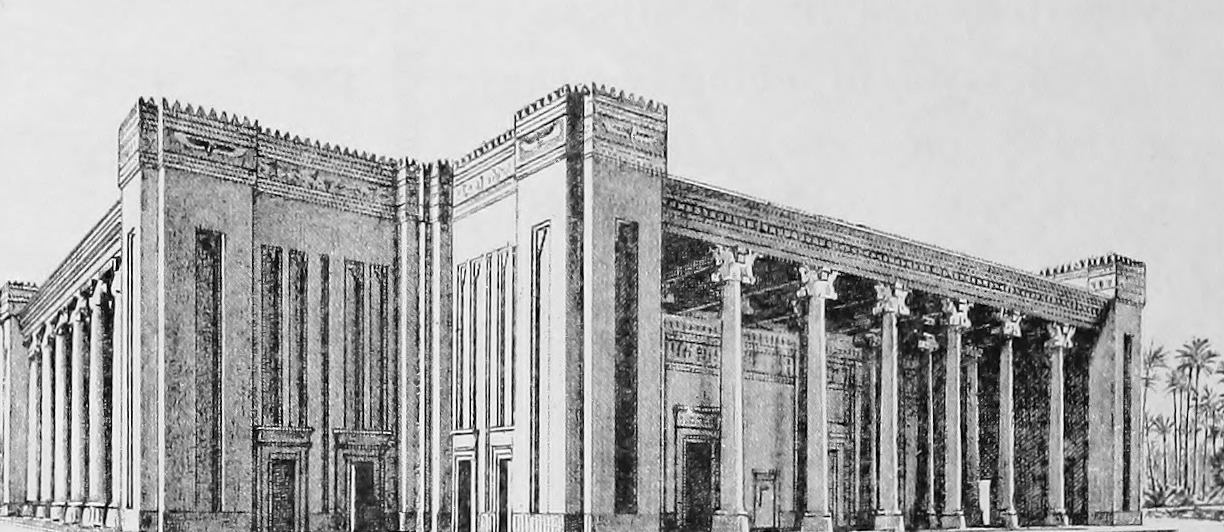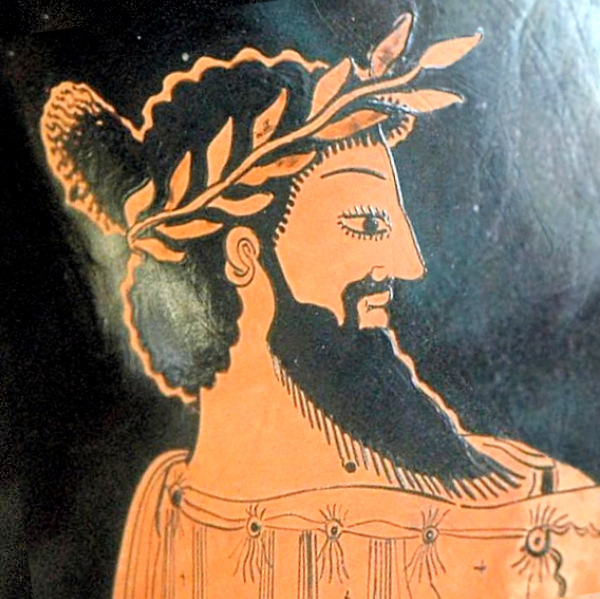The following is an excerpt (Chapter VII, pages 64-69) from Ancient and Medieval History (1946) by Francis S. Betten, S.J. Although some information may be outdated, the Catholic historical perspective it provides remains pertinent. Use the link at the bottom of post to read the previous/following pages. Use the Search box above to find specific topics or browse using the Resources tab above.
CHAPTER VII
THREE LATER EMPIRES: LYDIA, MEDIA, PERSIA
THE EMPIRES OF LYDIA AND MEDIA
66. Lydia was originally a small district near the western shore of Asia Minor, very fertile, and, like many of its neighbors, rich in minerals. Of the earlier Lydians we know little, and whatever literature they possessed is entirely lost. Their position between the highly cultured lands farther east and the islands and peninsulas of Europe encouraged trade and commerce. They invented coinage. About 650 B.C. Lydian kings began to stamp upon pieces of metal their names and pictures as a guaranty that the pieces had a certain value. Such pieces we call coins. Before long all the states of the time had their own coins. The first coins were of “electron,” a mixture of gold and silver, but coins of gold, silver, and other metals soon followed. In our days we do not realize that mankind got along for thousands of years without coined money. (See § 19.)
It must not be supposed, however, that “barter” disappeared entirely after 650. It always remained in the more primitive communities, and at times even became necessary in highly civilized states (§ 383).
Before Lydia invented coinage, it had become the head of an empire, which embraced all the small nations and states of Asia Minor west of the Halys River. It included also the Greeks of the coast cities of Asia Minor. These Greeks in particular helped to make Lydia a connecting link between the lands east of it and Europe in the west. The greatest Lydian king was Croesus, an excellent administrator, who amassed such riches that, with the Greeks, “rich as Croesus” became a byword. He was also Lydia’s last king, for during his reign Cyrus the Great, King of the Persians, conquered the land and made it a Persian province.

67. Media. — East of the Euphrates-Tigris region lay a stretch of mountainous land, which gradually rose up to the Plateau of Iran. In the northwestern section of these mountains and eastward around the head of the Caspian Sea lived the tribes of the Medes, a vigorous race, which accepted a good deal of culture from its western neighbors. The tribes consolidated into one kingdom. For several hundred years this was kept in subjection by Assyria. The time came when Media conspired with Nabuchodonosor of Babylonia against the common despot, and after the destruction of Nineveh (§ 49) divided with him the once mighty empire. The civilized world, as far as it concerns us, now consisted of four large powers, Media, Babylonia, Lydia, and Egypt. Friendly relations existed between these realms for more than two generations (H. T. F., “Generation”), an excellent chance for civilization to spread more thoroughly among the inhabitants. During this time, however, Media busied herself with the conquest of the barbarous tribes to the east, until she had practically the whole of the Plateau of Iran under her control. (Media did not contribute any new element to the common treasure of culture.) We are now on the threshold of another empire, which more than any of those which went before it deserves the proud title of “World Empire.”
THE EMPIRE OF THE PERSIANS
THE PEOPLE AND THEIR EMPIRE
68. Rise of the Persian Empire. — The little mountainous country of Persia proper lay northeast of the Persian Gulf. The Persians, close kinsmen of the Medes, had for a long time formed a separate kingdom which was subject to Media. In 558 B.C. Cyrus, King of the Persians, dethroned the King of Media by a “palace revolution” and put himself in his place as ruler of the entire Median Empire. He did not look upon himself as the founder of a new state. Hence it is that both in the Bible and in Greek literature the terms Medes and Persians are often used promiscuously.
Cyrus, the first ruler in history that is distinguished by the title “the Great,” at once entered upon a career of conquest. He conquered and annexed both Lydia and Babylonia. (He at once allowed the Jews to return to their land; see § 64.) His son added Egypt. Thus the Persian Empire included all the other empires, and was in reality a world power.

The conquest of Iran was completed. This empire comprised some seventy million inhabitants upon two million square miles. It reached from the coasts of the Aegean Sea to the regions of the Indus River, farther than New York is from San Francisco. It was the third great union of the Orient (§§30, 48).
69. Administration. — To make uprisings of subject kings impossible, the Persian rulers took up the system employed by the Assyrians. They divided their immense lands into provinces or “satrapies,” ruled over by “satraps” whom the king could appoint or dismiss at will. The Persians improved on it very greatly. The satrap had no army at his disposal, and so could not think of offering resistance to the central government. Besides there was in every satrapy an independent royal secretary, “the king’s ear,” who constantly reported on the satrap’s actions. At certain intervals a special officer, “the king’s eye,” appeared in the satrapy with an armed force to make investigations and set matters right. Meanwhile the “Great King” — this was the title given to the ruler — interfered little with the language and customs of the many nations under his sway, though here and there a country or a city was dealt with rather harshly. This efficient system was the work of a later king, Darius the Great, a distant relative of Cyrus. It went far to reconcile the subject nations to their lot. Like the kings of Egypt and Babylon, the Persian rulers were absolute despots. The prosperity of their subjects was to be brought about by royal officials who governed according to directions laid down by the kings themselves.

70. Persia and the Scythians. — The Scythians, a fierce people, half nomads, half robbers, lived in the countries north of the Black Sea and Caspian Sea, and farther east. During the time of the Assyrian Empire they had repeatedly come down on their fleet horses and carried death and destruction deep into the civilized countries, plundering as far as Egypt. The Median Empire was the first to put a stop to these inroads, but it remained the task of the Persian power to keep them out, and nobly did Persia deliver herself of this duty. Her kings even undertook punitive expeditions into the Scythian country.
CULTURE IN THE PERSIAN EMPIRE
71. The Persians as a nation have contributed very little in the line of arts and literature. They themselves were too busy with the affairs of government. They simply adopted what arts they found in the old homes of civilization. In architecture, however, they used stone very extensively, and shaped columns and other details in a new manner. A cuneiform writing was devised for the Persian and many other languages of the empire. Their literature, generally speaking, is the literature of the countries of the empire.
The Persians were the first great road builders of the world. An excellent system of highways, furnished with milestones, inns, ferries, and bridges, connected the parts of the vast domain. A mighty trunk road, 1500 miles long, ran from Sardis to Susa. (See the map facing page 67.) Phrygians, Lydians, Greeks, Babylonians, rich merchants with wagonloads of their wares, poor peasants driving their donkeys laden with goatskins filled with oil or wine, stately trains of satraps and ambassadors of foreign countries — all traveled on these roads in perfect safety. For its own use the government had devised a postal service. Post riders, relayed at certain stations, carried dispatches with incredible swiftness, in six days it is said, from end to end of the main road, while ordinarily the journey took three months. Carriages, relayed at certain intervals, transported persons of rank or government officials. In a most peaceful manner these roads served to “set the world a-mixing,” to make every province the participator in the achievements of all others.
72. Religion. — We know nothing about the kind of religion which the Persians practiced before they came into the limelight of history. When they appeared they had adopted the teachings of Zoroaster (about 1000 B.C. ?), which are laid down in the Avesta, the Persian Bible. According to the Avesta there is one good god, called Ahura Mazda, or Ormuzd, who created all good things; and another god, called Ahriman, who is bad and created all evil things. Those who observe the commandments of Ahura Mazda will be rewarded in the next world; if anyone sins, the door is open for repentance. But those whose evil deeds outweigh the good will suffer in a terrible hell of fire. In the end Ahura Mazda will conquer. There will be a general resurrection from death, and Ahriman will be destroyed. The outward sign of Ahura Mazda, and as it were his robe, is the light; hence their veneration for the sun and fire.
73. The moral system, as far as we know, was nobler and purer than that of any other ancient nation except the Hebrews. Virtues and vices are enumerated much as in Christian ethics. Special stress is laid on purity, — material cleanness included, — on charity and kindness, and on truthfulness. Lying is one of the greatest evils; “may Ahura Mazda protect this land from hostile inroads, from bad harvests, and from lying.” The youths of the Persian nobility were trained to ride, to shoot with the bow, and to tell the truth. Agriculture was raised to the dignity of a religious duty.


